#trait: plesiosaur
Explore tagged Tumblr posts
Text




Gomamon EX8-018, Dolphmon EX8-020, Whamon EX8-025, and Plesiomon EX8-027 by naru from EX-08 Extra Booster Chain of Liberation
#digimon#digimon tcg#digimon card game#DCG#デジカ#digica#digisafe#Gomamon#Dolphmon#Whamon#Plesiomon#naru#EX8#digimon card#color: blue#Lv3#Lv4#Lv5#Lv6#type: vaccine#type: data#trait: sea beast#trait: sea animal#trait: plesiosaur#trait: DS#Deep Savers#num: 04
212 notes
·
View notes
Text

Paleo-Files: Aegirocassis
Aegirocassis benmoulai is a species of giant, 2.3-meter-long filter-feeding arthropod that lived about 480-472 million years ago in the depths of the early Ordovician seas of what is now the Fezouata Formation of Morocco. Ever since its discovery in 2015, Aegirocassis is considered to be the first giant, aquatic, filter-feeding animal that evolved in Earth’s history, preceding the evolution millions upon millions of years later of future large, marine filter-feeders such as the Jurassic ray-finned fish Leedsicthys, the Cretaceous plesiosaur Aristonectes and the baleen whales and whale sharks of the Cenozoic. It was also the largest member of the Hurdiidae, a diverse family of marine radiodont arthropods of the Cambrian and Ordovician periods that includes the famous carnivorous Anomalocaris, and it might have evolved its filter-feeding traits, such as endites or inner structures of its frontal appendages that bore large amounts of baleen-like auxiliary spines that could have been used as a sort of mesh, from smaller, carnivorous ancestors as a result of the Great Ordovician Biodiversification Event, in which certain environmental changes at the time witnessed the diversification of plankton, and in turn the flourishing of new suspension-feeding organisms. The spines of this strange arthropod’s frontal appendages were inward-angled, which allowed them to overlap to a certain degree and thus allow for more control over the size of the filtering mesh, and this unique feature may halve allowed Aegirocassis to feed on bigger-sized zooplankton than other filter-feeding radiodonts, along with large carapace that could have also helped to guide the feeding current to the frontal appendages. Aegirocassis shared its deep-sea habitat with the closely-related radiodont Pseudoangustidontus and several other, smaller arthropods, microorganisms and trilobites, and was also the single largest member of the highly-diverse Fezouata biota.
#paleoart#paleontology#aegirocassis#arthropod#arthropods#ordovician#paleozoic#paleozoic era#paleontology art#paleoartwork#palaeoart#palaeontology#paleography#paleoblr#palaeoblr#prehistoric animals#palaeontology art#artists on tumblr#paleoartists on tumblr
40 notes
·
View notes
Text
!!!!!!!!!DINOMONKEY AU TIME!!!!!!!!!
ALRIGHT GANG LETS GO;
everyone gets a dinoperson form. basically they get increased size (they're all at least 10ft tall in dinoform) and usually a few other traits like teeth, horns, and a dino tail. for some of them their hair gets longer/rougher (as in, their appearance looks more "wild").
people can shift in between their regular forms and their dinoforms
MK is a t-rex!! he gets t-rex teeth + a t-rex tail.
Mei is a plesiosaur!!! she gets the teeth + tail
Red Son is a tricerotops!! he gets two horns on the side of his head, one horn in the middle of his forehead, and a tail
Wukong is a stegosaurus!! he gets the spikes/plaques going down his back, and he gets a dino tail!! he keeps his monkey tail though, he gets two tails (this is a trait unique to him)
Macaque is a pterodactyl, he's got wings (he doesn't get a tail though). one of his wings has a hole in it from his beach trip to hell.
Tang is a velociraptor-
Pigsy is also a t-rex!! father son duo type vibes
Sandy is a brachiosaurus. he's the biggest out of all of them in dino form.
with that out of the way lets move on to other fun details;
with the plaques on his back + his laser eyes, Wukong is basically a knockoff Godzilla. he gets VERY mad whenever someone brings this up- "GODZILLA WAS BASED OFF OF ME. I should sue them actually I should be getting royalties from this-"
MK and Mei have this super specific joke they like to do in front of people to freak them out, where MK will bite Mei's arm and Mei will pretend to just die instantly. Wukong loses his mind with panic when they do this in front of him for the first time
there's no way to guess what kind of dino someone is unless you see them in dinoform. most people (including Wukong and Red Son) assume MK is some kind of herbivore. MK takes great pleasure in scaring the shit out of people when they find out he's a t-rex.
there's no real carnivore vs herbivore thing going on here, everyone still basically has a human diet, there's just a slight inclination towards eating meat or vegetables
Red Son keeps both meat and fish kebabs in a lil pocket dimension and pulls them out and cooks them whenever Mei or MK say they're hungry. ...Or just when they look at him a little weirdly. Listen, Mei bit his hand once and he may or may not be a bit traumatized from it-
i need you all to take a moment and imagine Porty MK with T-rex traits. thank you for taking a moment, moving on now,
since Macaque's dinoform is injured (giant hole in wing), he stays in his regular monkey demon form 98% of the time.
this means that when grouped with the others, theres this tiny 5'2" monkey demon surrounded by at LEAST 10ft tall dinopeople. he looks so small. post!redemption arc the others sometimes just carry him around
MK loves to pretend to hunt people down. it was a game him and Pigsy would play when he was younger and he never grew out of it. this leads to other people getting surprise tackled by him semi-frequently.
thats all i got rn cause i literally made this AU last night but just: dinomonkeys.
35 notes
·
View notes
Text
Creepy Redneck Dinosaur Mansion 3 Is OUT NOW! + FAQ
Firstly, our match-3 survival horror comedy RPG metroidvania you didn't know you needed is OUT NOW! Here's the launch trailer!
youtube
Now, the 3 in the title may need a little explanation so we put together this handy FAQ. FAQ: WHAT IS CREEPY REDNECK DINOSAUR MANSION 3?
WHAT IS CREEPY REDNECK DINOSAUR MANSION 3?
It’s a video game!
Also, we’re calling it the match-3 survival horror comedy RPG metroidvania you didn't know you needed. A “matchroidvania”, if you will. And you should, because that’s what we’re calling it.
DO I NEED TO PLAY CREEPY REDNECK DINOSAUR MANSION OR CREEPY REDNECK DINOSAUR MANSION 2 TO UNDERSTAND?
So, there is no Creepy Redneck Dinosaur Mansion 1 or 2. This game was originally intended as a sequel to two games that didn’t exist, because we thought it would be funny.
Then the game industry took a nosedive, and this game got cancelled, un-cancelled, and cancelled again.
When we started on CRDM3 for the third and final time, we saw an opportunity to use this sequel to a series that doesn’t exist to actually say something about the game industry, and the process of making a game in 2025. You’ll probably appreciate a lot of the jokes if you’re a game developer, but if you aren’t, we hope the game is both understandable and a good introduction to that secret world of knowledge and context you usually only get from being prematurely aged by this hellfire of an industry first.
DID THE TEAM CHANGE DURING ALL THOSE CANCELLATIONS? HOW DOES THAT IMPACT DEVELOPMENT?
Our team composition naturally changed over time as we ran into lulls or developers moved on to other projects. The result is a game that doesn't just have a false history--but a real one. Everyone who has ever worked on CRDM3 is somewhere in the project, with a joke, a piece of art, or just an idea crafted with genuine care. We hope the game finally getting the chance to launch honors their contributions.
THIS LOOKS LIKE A MOBILE GAME! WHY DOES IT USE MATCH-3 MECHANICS?
We were inspired by Puzzle Quest and Puzzle & Dragons, games that use these mechanics in a similar way, but mostly focus on combat. It seemed to us that there was wiggle room to explore conflict and characters through these mechanics, so we built a really robust Match-3 system with things like character traits, consumable items, stress meters, and more!
It means that using the same grid of simple symbols, everything from crafting a cursed hunting rifle, to hacking a mainframe, to trying to out-cowboy a plesiosaur, can be done with the same core mechanics--massively expanding the range of things you can do in the typical RPG.
WILL WE EVER GET A CREEPY REDNECK DINOSAUR MANSION 1 OR 2?
If there’s interest in more, we’ll be listening! For now, we hope you enjoy what we’ve made and the place that it comes from.
WILL WE EVER GET A CREEPY REDNECK DINOSAUR MANSION 4?
No.
----------- We hope you enjoy our weird-ass game with Dinosaurs and match-3 and a not subtle commentary on the games industry. Also, fun fact, on the steam page right now you can watch me playing the game! I do voices and everything! See you on the internet, - Chris @ Strange Scaffold.
#game development#indie dev#indie games#gaming#match 3 games#match 3#dinosaur game#indie gaming#pc games#pc gaming#Youtube
9 notes
·
View notes
Text
Fossil Novembirb: Day 3 - Race to the Sea

During the start of the Cenozoic, the oceans were relatively empty. Gone were the great marine reptiles like mosasaurs and plesiosaurs, as were ammonites and many large predatory fish. As soon as birds could, they entered the ocean to reap its bounties, whether by flying over the surface or diving to the depths. This is especially evident in Aotearoa (New Zealand), where lots of early seabirds, including the first penguins, were found in Paleocene sediments dating about 62 million years ago.
Kumimanu: One of the largest known penguins, and one of the earliest, standing over 1,5 metres tall and weighing 90-150 kilograms.
Sequiwaimanu: Another early penguin, known from a skull that preserves a long, spear-like beak.
Muriwaimanu: A relatively small early penguin. Like other early penguins, it had relatively long legs and somewhat flexible wings.
Kupoupou: A small early penguin with derived traits, like a flipper-like wing and short legs.
Waimanu: The earliest known penguin, and also relatively large at the size of the modern king penguin (Aptenodytes patagonicus)
Protodontopteryx: The earliest known pelagornithid, large soaring marine birds. This earliest member of the family sports a "modest" 2-metre wingspan.
Clymenoptilon: An early representative of tropicbirds that may have lived somewhat like a tern.
#Fossil Novembirb#Novembirb#Dinovember#birblr#palaeoblr#Birds#Dinosaurs#Cenozoic Birds#Kumimanu#Sequiwaimanu#Kumiwaimanu#Kupoupou#Waimanu#Protodontopteryx#Clymenoptilon
48 notes
·
View notes
Text

Gomamon (X Antibody) BT15-021 U <03>
Rookie | Vaccine | Sea Beast/X Antibody
[Digivolve: [Gomamon]: Cost 0]
[On Play] [When Digivolving] Reveal the top 3 cards of your deck. Add 1 card with the [Sea Beast], [Plesiosaur], [Beastkin] or [X Antibody] trait among them to the hand. Return the rest to the bottom of the deck.
---
Inherited: [When Attacking][Once Per Turn] Until the end of your opponent's turn, 1 of your opponent's Digimon with as many or fewer digivolution cards as this Digimon can't attack.
#digimon#digimon tcg#digimon spoilers#bt15#sometimes I forget I post these and im reading them somewhere else and im like oh that’s a cool card when did that get spoiled… oh wait
19 notes
·
View notes
Photo

Double Plesiosaur Vertebrae Fossil, Oxford Clay, Jurassic Stewartby UK | Articulated Marine Reptile + COA
Double Plesiosaur Vertebrae – Oxford Clay Formation, Callovian Stage, Middle Jurassic, Stewartby, Northamptonshire, United Kingdom
This impressive fossil consists of two Plesiosaur vertebrae originally found articulated and separated during professional preparation. These vertebrae come from the Oxford Clay Formation, dating to the Callovian stage of the Middle Jurassic, approximately 165 to 160 million years ago, and were discovered near Stewartby, Northamptonshire—an area historically significant for vertebrate fossil finds.
Fossil Type & Species:
Type: Vertebrate Fossil (Plesiosaur Vertebrae – originally articulated)
Clade: Sauropterygia
Order: Plesiosauria
Superfamily: Plesiosauroidea or Pliosauroidea (specific assignment undetermined)
Common Name: Plesiosaur (Marine Reptile)
Described by: Many species described from Oxford Clay, including Cryptoclidus, Muraenosaurus, and Peloneustes by early palaeontologists like Seeley and Owen
Geological & Stratigraphic Details:
Location: Stewartby, Bedfordshire–Northamptonshire region, UK
Formation: Oxford Clay Formation
Geological Stage: Callovian (Middle Jurassic)
Age: ~165–160 million years ago
Biozone: Peltoceras athleta ammonite zone (regionally correlated)
Depositional Environment: Shallow marine basin with low-oxygen bottom waters, ideal for the preservation of vertebrate remains in finely laminated marine mudstones
Morphology & Features: These two vertebrae exhibit classic plesiosaurian traits:
Cylindrical centra with concave articular surfaces (amphicoelous)
Flat dorsal and ventral surfaces typical of marine-adapted vertebrates
Distinctive surface texture and bone grain, with no artificial reconstruction
Separated from one another during cleaning but originally discovered as an articulated pair
Natural coloration in earthy browns and greys from mineral-rich clay matrix
Notable: Plesiosaurs were among the dominant marine predators of the Jurassic seas. Their fossils are relatively scarce compared to ammonites and invertebrates, making vertebral specimens highly desirable. Double vertebrae finds—especially originally articulated—are rarer still and represent a more complete snapshot of the animal’s skeletal structure.
Specimen Details:
Origin: Stewartby, Northamptonshire, UK
Fossil Type: Double Plesiosaur Vertebrae (Marine Reptile)
Geological Stage: Callovian, Middle Jurassic
Formation: Oxford Clay
Preservation: Originally articulated; now cleaned and separated but displayed together
Size Reference: Scale cube = 1cm (see photos for full sizing)
Note: The exact specimen shown in the photo is the one you will receive
Authenticity & Quality: This fossil is 100% genuine and has not been restored or artificially altered. It comes with a Certificate of Authenticity and was professionally cleaned to preserve anatomical detail.
Why Choose This Fossil? Perfect for:
Serious fossil collectors and palaeontology enthusiasts
Museum-quality marine reptile displays
Educational exhibits on Jurassic marine ecosystems
Rare vertebrate fossil investment
Shipping & Packaging: We ship using eco-conscious materials and track all deliveries. Each fossil is packed securely and handled with care.
Secure a rare piece of Jurassic marine history with these authentic Plesiosaur vertebrae from the Oxford Clay of Stewartby.
All of our Fossils are 100% Genuine Specimens & come with a Certificate of Authenticity.
#Plesiosaur vertebrae fossil#Jurassic marine reptile bones#Oxford Clay plesiosaur#Stewartby fossil reptile#double vertebrae fossil#real plesiosaur bone UK#fossil with COA#marine reptile vertebrae#Jurassic Northamptonshire fossil#articulated plesiosaur vertebrae#Oxford Clay fossil vertebra#UK plesiosaur specimen#Jurassic vertebrate fossil#collector fossil reptile bones
0 notes
Text
What Are The Types Of Living Reptile Fossils?
Reptiles, an ancient and diversified animal order, have left a fascinating fossil record that sheds light on their evolutionary history. Fossils provide a glimpse into the distant past and aid in explaining the various varieties of reptiles that previously walked the world. These prehistoric relics have survived in various forms, allowing paleontologists to classify living reptile fossils. Each type of living reptile fossil, from the fearsome dinosaurs to the gorgeous sea reptiles and the forefathers of present reptilian species, tells a distinct story of adaptation and survival. In this writeup, we will explore and learn about them.
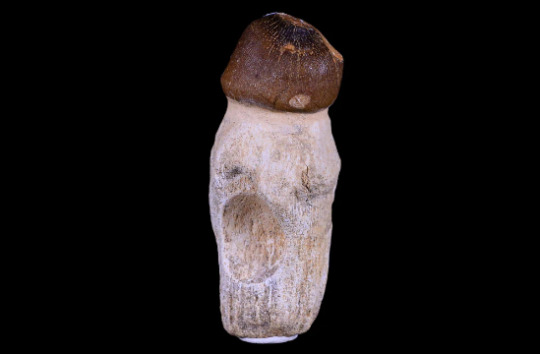
Learn About The Types Of Living Reptile Fossils
Reading the below pointers, you will find information about the different types of living reptile fossils.
1. Dinosaur Fossils
Dinosaur fossils are the most famous and captivating examples of living reptile fossils. These ancient giants once dominated the Earth during the Mesozoic era. Fossilized bones, tyrannosaurus rex teeth, and even footprints provide crucial information about their anatomy, behavior, and ecological roles. They are classified into various groups. For example, sauropods, theropods, and ornithischians exhibit distinctive characteristics and adaptations.
2. Plesiosaur And Ichthyosaur Fossils
Plesiosaurs and ichthyosaurs are iconic marine reptiles from the Mesozoic era. Plesiosaurs had long necks and large flippers, while ichthyosaurs had streamlined bodies resembling modern dolphins. Fossils of these sea-dwelling reptiles have been discovered in various parts of the world, revealing their aquatic lifestyle and evolutionary traits.
3. Pterosaur Fossils
Pterosaurs were flying reptiles that were in existence during the Mesozoic era. Fossils of their impressive winged structures, known as pterosaurs, provide insights into their flight mechanics and adaptations for aerial life. These reptiles were the first vertebrates to achieve powered flight, and their fossils showcase a wide range of sizes and shapes.
4. Mosasaur Fossils
Mosasaurs were powerful marine reptiles that existed during the Late Cretaceous period. These apex predators were adept swimmers due to their lengthy bodies, powerful jaws, and well-developed flippers. Mosasaur fossils have been discovered in marine sediments, demonstrating their importance in ancient marine ecology.
5. Archosaur Fossils
The archosaurs are a reptile class incorporating dinosaurs, pterosaurs, and crocodilians. Their fossils give a total image of the developmental connections between these reptilian taxa and their normal predecessors. They provide critical evidence to decipher these ancient creatures' common features and characteristics.
6. Crocodilian Fossils
Crocodilians, including alligators, crocodiles, and caimans, are living reptiles traced back to prehistoric times. Fossilized remains of their ancestors provide insights into their morphological changes and adaptations throughout geological ages, revealing the history of their survival and diversification.
7. Turtle Fossils
Turtles are ancient reptiles with a unique bony shell covering their bodies. Turtle fossils dating back to the Triassic epoch have been discovered. These fossils have been crucial in understanding turtles' evolution and their characteristic shell formation.
8. Snake And Lizard Fossils
The fossil record of snakes and lizards provides essential evidence of their evolutionary history and adaptations. Fossilized snake skeletons have shed light on the transition from limbed to limbless forms, while ancient lizard fossils have revealed the diversity of these creatures in prehistoric ecosystems.
Looking For Authentic Reptile Fossils? Reach Them!
Fossil Age Minerals is a well-known company that collects prepares, and sells high-quality reptile fossils and minerals. With a passion for paleontology, they provide a comprehensive variety of ancient reptile fossils from well-known geological formations worldwide, including dinosaurs, pterosaurs, and marine reptiles. Their expert team ensures each specimen's authenticity and scientific significance, making them a trusted source for collectors, educators, and museums. Committed to preserving Earth's prehistoric heritage, Fossil Age Minerals provides a unique opportunity for enthusiasts and researchers to own a piece of history, unraveling the mysteries of ancient reptilian life through their remarkable fossil collections.
0 notes
Text
Round Two: Stegouros vs Spicomellus
Stegouros elengassen
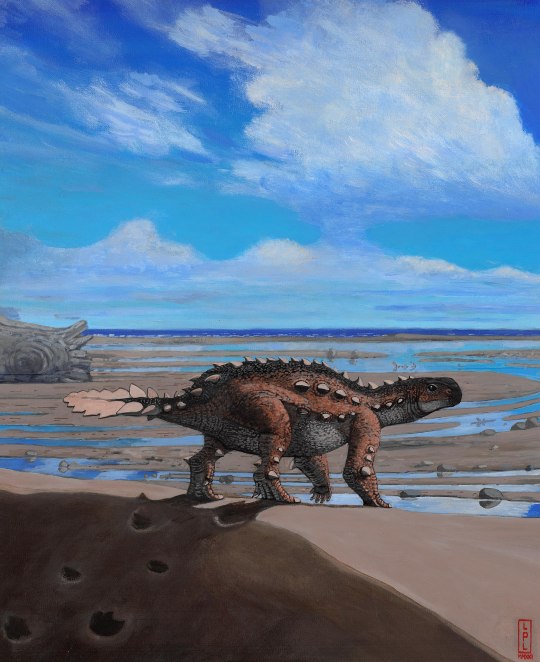
Artwork by Luis Enrique Pérez López, written by @zygodactylus
Name Meaning: Armored Creature with a Roofed Tail
Time: 74.9 to 71.7 million years ago (Campanian to Maastrichtian stages of the Late Cretaceous)
Location: Dorotea Formation, Patagonia, Chile
South America is just where the nonavian dinosaur party is happening these days! Stegouros is another recently described species from this continent, and another weird one - it was an Ankylosaur, but not a Nodosaur or an Ankylosaurid, and more to the point, instead of a tail club it had a series of vertebrae enclosed in osteoderms, in a shape that looked a lot like a macuahuitl - the tail was also very short, shorter than any other Thyreophoran, with flattened vertebrae coming together to form the strange and distinctive shape (similar short vertebrae are known from its relative, Antarctopelta). At around 2 meters long, it was very small for an Ankylosaur, though it had a head that was quite large for its body. It also had inward curving teeth, making them look vaguely hourglass-shaped, though they were also asymmetrical. It had many typical ankylosaur traits, but also some stegosaurian ones such as hollow sides to their vertebrae. Overall, it was very similar in proportions and appearance to Antarctopelta, indicating Antarctopelta may have looked more like Stegouros than previously thought. It had limb bones similar to cursorial Ankylosaurs, indicating Stegouros itself was a fast and efficient mover; and it even had claws shaped like hooves which may have enabled even more efficient running and locomotion. So, yeah. A short big headed ankylosaur built for running with a freaking ax on its tail. That’s normal! Living in the Dorotea Formation, Stegouros probably lived near the coast, alongside different sorts of mammals, fish, bivalves, amphibians, plesiosaurs, turtles, and unnamed dinosaurs such as opposite birds, megaraptors, Unenlagiines, and possible titanosaurs.
Spicomellus afer
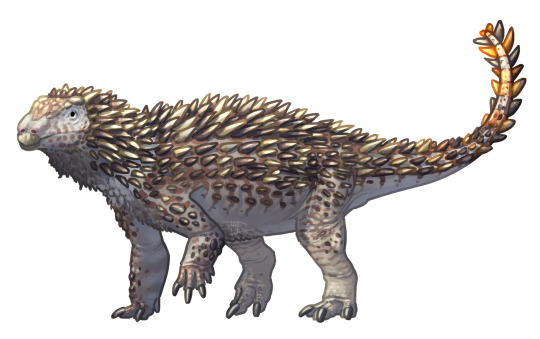
Artwork by @i-draws-dinosaurs, written by @zygodactylus
Name Meaning: African Collar of Spikes
Time: 168 to 164 million years ago (Bathonian to Callovian stages of the Middle Jurassic)
Location: Third Subunit, El Mers Group, Fès-Meknès, Morocco
Spicomellus is the oldest known Ankylosaur, and also the first described Ankylosaur from North Africa! But that isn’t even the weirdest thing about it! Spicomellus had dermal spikes, fused to the bone, forming a collar (for which it was named) around its neck. Given that the spike were fused to the underlying bone - something no other ankylosaur does - it is probable that it wouldn’t have had a particularly flexible neck, or an easy time moving in general if the pattern continued throughout the body. It probably would have been around 3 meter long at the most, similar in size to other ankylosaurs from the Middle Jurassic. Coming from the El Mers Group, i tlived alongside Cetiosaurus, the stegosaur Adratiklit, megalosaurs, and teleosaurids. Spicomellus adds to a growing diversity of Jurassic Ankylosaurs, showing how Ankylosaurs and Stegosaurs lived alongside each other for a large period of time (the Middle and Late Jurassic epochs) and that the extinction of the Stegosaurs must have been due to a different, unrelated factor.
#dmm#dinosaur march madness#dinosaurs#birds#dmm rising stars#dmm round two#birblr#palaeoblr#paleontology#bracket#march madness#polls#stegouros#spicomellus
212 notes
·
View notes
Text
Wednesday 2/6/21 - Your Pterosaurs Are Wrong

Mark Witton, Cimoliopterus
A few weeks ago, I made a post talking about dinosaurs, and some common mistakes that artists make when reconstructing them. A lot of these issues bleed into how dinosaurs look in mainstream media, so I wanted to show what scientists know is the right way to do a dinosaur.
But dinosaurs weren't the only reptiles alive at the time, and many other ancient reptile groups also feature heavily in pop culture... and they're done just as dirty. Today I wanna talk about a group closely related to dinosaurs, the Pterosaurs, and the various way they're misreconstructed.
Firstly: Pterosaurs aren't Dinosaurs
Most people with at least a passing interest in dinosaurs understand that dinosaurs were not the only group of reptiles widespread in the Mesozoic. But the other day, my sister was approaching me for information she could link to a cheap bag of "dinosaur" toys. Among Tyrannosaurus and Triceratops, there was also other reptiles like Pteranodon and Elasmosaurus, and I was shocked to find that the fact that not all of these were dinosaurs was not common knowledge.

A typical cheap assortment of plastic "Dinosaur" toys
I might tackle extinct marine reptiles in the future, but for now, the basics to know is that most dinosaurs were not strong swimmers; plesiosaurs, icthyosaurs, and mososaurs were not dinosaurs. And the only flying dinosaurs had feathered wings; birds and their close extinct relatives. Pterosaurs, which fly with stretched membrane wings, are not dinosaurs.
Pterosaurs are closely related to dinosaurs, both groups share the very light bone structure that allowed flight to develop in each group. Ornithodira (bird-neck), is the name of the group containing the oldest ancestors of dinosaurs and pterosaurs, and their descendants. But that's enough cladistics. Let's get to physical inaccuracies.
Bipedal vs Quadrupedal
The classic image of a man-shaped Pterosaur standing on its hind limbs like a vulture is very verrrry outdated. We now know that, like modern membrane-winged bats, pterosaurs walked on all fours on the ground. And they weren't clumsy either, some larger species may have hunted on the ground too.

The Lost World: Jurassic Park, Pteranodon (inaccurate)

Mark Witton, Thalassodromeus (accurate)
This quadrupedal stance helped pterosaurs take off with all four limbs, a much more powerful leap. Meaning that pterosaurs could reach greater sizes than any other flying animal in history. Another, minor quip, is that the fingers of the front limbs faced backwards when pterosaurs were grounded.
Wings were not pointed

Walking With Dinosaurs, Ornithocheirus (now inaccurate wings)

Julio Lacerda, Pteranodon (accurate wings)
When you draw a pterosaur it can be very easy to draw mishapen pointed triangles for the wings, but if you're going for a scientifically accurate depiction, the edges of a pterosaur wing were actually slightly rounded, and this helps reduce drag. Which is important in particular for gliding and soaring species.
Tails... were not Universal
The earliest ancestors of pterosaurs were likely a quadrupedal, possibly arboreal species, and would have definitely had a tail. But as pterosaurs diversified and got bigger, there was a trend toward a smaller tail.

Gabriel Ugueto, Articodactylus (a tailed Pterosaur)

Brian Engh, Nyctosaurus (a tailless Pterosaur)
The stereotypical long, arrow-headed tail was present in some species for sure, but the bigger crested species like Pterodactylus did not have tails.
Scaly Monsters?
Like many mainstream misrepresentation of dinosaurs, pterosaurs have long been shown off as serpent-like monsters with bare, scaled skin. I mentioned in the Your Dinosaurs Are Wrong post that even very primitive feathers are ancestral to all dinosaurs, and some palaeontologists think that this ancestral trait might extend to all of Ornithodira.
Most, if not all Pterosaurs, possessed hair-like filaments called Pycnofibers. In dinosaurs, this fuzz gave rise to feathers, but in pterosaurs, they developed into fluff that was superficially analogous to mammal fur. So rather than shrink wrapped scaly monsters, more accurate pterosaurs would've appeared fairly furry. But like dinosaurs, this would vary between genera.

Walking With Dinosaurs, Anurognathus (now inaccurate)

Andrey Atuchin, Anurognathus (accurate)
Thanks For Reading
These things I've mentioned today are the main glaring inaccuracies that pop up in PaleoMedia and mainstream SciFi in general. There's a couple other smaller things that I wouldve brought up, but tumblr only allows 10 images in one post.
The clade Pterosauria is also very varied, so smaller gripes, such as toothless jaws or wings without external fingers, may be inaccurate in some groups, but they are perfectly accurate in others (the toothless Quetzalocoatlus, and fingerless Nyctosaurus for example).
Cheers for the read, and if you want me to tackle other groups of ancient animals and their misrepresentation in media, let us know.
Also check out Dr Mark Witton on his twitter, and his blogspot. He is very skilled paleoartist, and I use a lot of his art in general, but he's also a palaeontologist who is very knowledgeable in Pterosaurs.
3K notes
·
View notes
Text
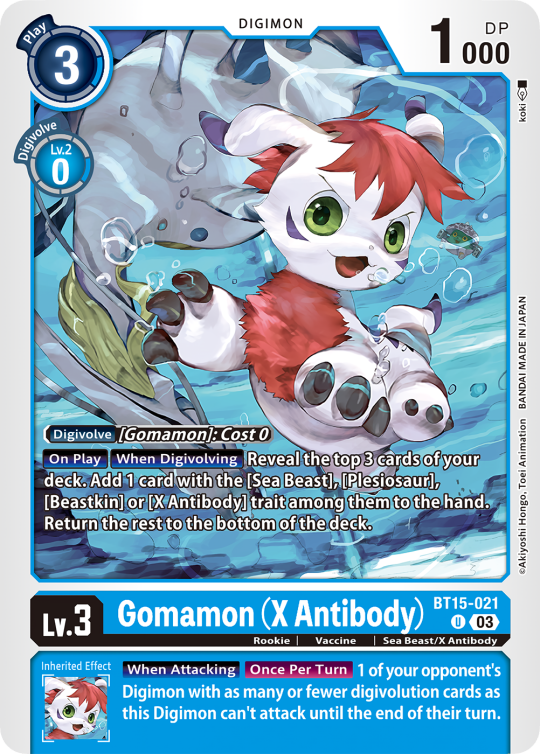
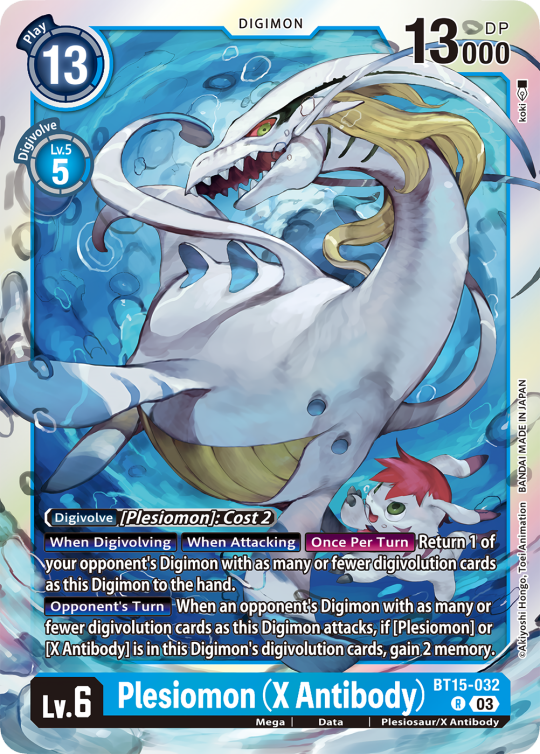
Gomamon (X Antibody) BT15-021 and Plesiomon (X Antibody) BT15-032 by koki from BT-15 Booster Exceed Apocalypse
#digimon#digimon tcg#digimon card game#digisafe#digica#デジカ#BT15#GOmamon X#Plesiomon X#koki#digimon card#color: blue#Lv3#Lv6#type: data#type: vaccine#trait: sea beast#trait: plesiosaur#trait: x antibody#num: 03
208 notes
·
View notes
Text
Welcome back to my series covering the real life origins of all non-fish aquatic Pokemon. Today we will be finishing generation I. See the first part of Generation I here and the fish of generation I here.
The Krabby line are crabs. There’s really not much more to them than that. Well Kingler having one claw larger than the other is a reference to several species of crab with that trait, perhaps most famously the fiddler crab.
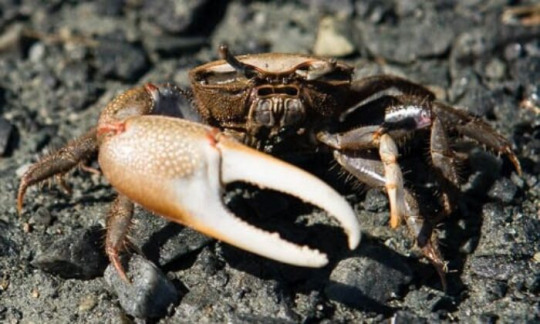
(image: a male fiddler crab)
Fiddler crabs, of which there are many species, have evolved a form of sexual dimorphism where the male has one claw that is much larger than the other. Males use their claws for sexual selection, both by waving the claw to attract females and fighting rival males. The crown of spikes on it can reference many spiny crabs, especially the king crab.

(image: a weird looking hedgehog king crab)
Gigantmax Kingler’s massive size and long, spindly legs could be a reference to the Japanese spider crab, which has the longest legspan of any crab. The bubbles are there because crabs will blow bubbles over their gills while on land.
Starmie and Staryu are stylized starfish and much like real starfish, they are radially symmetrical and can regenerate any lost arms as long as the center is intact. Real starfish have such efficient regeneration that if you cut one in half, as long as enough of the central disc in intact, you will get two starfish.
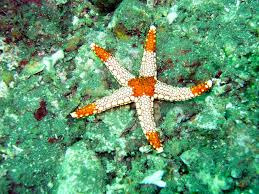
(image: a starfish)
Starmie and Staryu are heavily implied to be aliens, meaning they are likely also a reference to the common five-pointed star and shooting stars. Starfish have been compared to aliens before due to how strange they are to our vertebrate-centered view of life. Most starfish have five arms like Staryu, but a few have more, like Starmie (they still have 5 radial body segments, just more than one arm per segment. The line’s tendency to swim by rapidly rotating their bodies and their good speed stats could reference propellers and shuriken. The gems flashing, acting as their hearts, and firing beam attacks may all reference the flashing chest-mounted gems found in the Ultraman series.
I covered Magikarp in my fish posts, but didn’t cover Gyarados then as I don’t think it’s a fish. I think it’s a combination sea serpent and eastern dragon. It has the serpentine, limbless shape of sea serpents and the whiskers and carp connection of dragons. Eastern dragons are generally considered benevolent, but can be extremely dangerous when angered. They can also typically fly despite being wingless, fitting Gyarados having the flying type and actually flying around the sky in Legends: Arceus. Eastern dragons are often depited as having long barbels like those of carp and catfish.
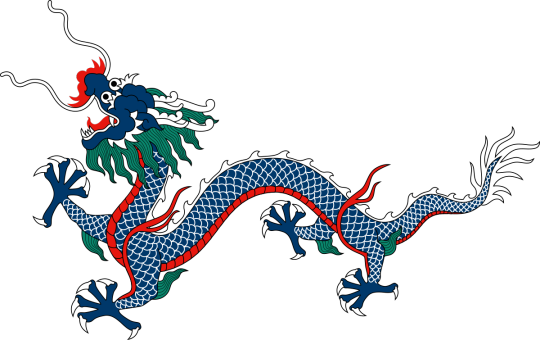
(image: a depiction of a Chinese dragon)
Gyarados evolving from Magikarp is a reference to a Chinese legend where a carp that jumps over a waterfall will turn into a dragon. If Gyarados has the appearance of an eastern dragon, it has the violent temperament of a western dragon. It’s violent and easily angered temperament is similar to legends of sea monsters attacking and destroying ships. Side note: Gyarados’s English name was originally going to be Skulkraken, which is one of the most metal things I’ve ever heard. Mega Gyarados looks a lot like carp streamers, which makes it amusing that the form based on a wind sock loses the flying type.
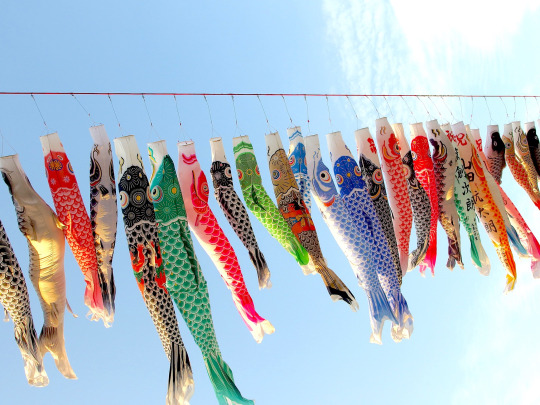
(image: a bunch of carp streamers)
Lapras is one of my favorite Pokemon of all time and its origin is suitably interesting. It’s based on famous lake cryptids like the Loch Ness monster, which are often depicted as looking like outdated reconstructions of plesiosaurs. Plesiosaurs were marine reptiles that coexisted with dinosaurs, but were not dinosaurs themselves. The most famous plesiosaurs, which Lapras is based on, had long necks.
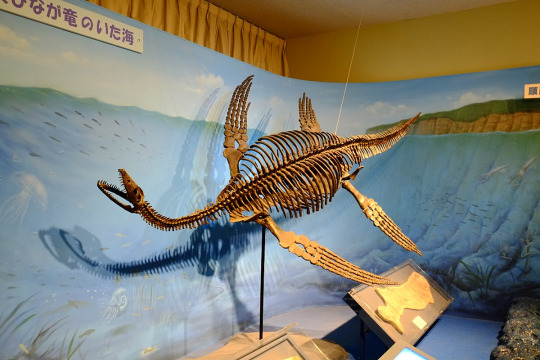
(image: a fossil reconstruction of Plesiosaurus)
Outdated reconstructions of plesiosaurs, often depicted them as being able to hold their necks out of the water in what is often described as a swan neck pose, much like Lapras’s neck. We now know that their necks were not nearly flexible enough to do that. I initially thought that Lapras’s shell was a reference to sea turtles, but it turns out it comes from the placodonts, close relatives to plesiosaurs who had bony plates on their backs that in some species developed to look a lot like turtle shells.

(image: a fossil reconstruction of a turtle-like placodont)
Some placodonts also had bony protrusions on their skulls, much like Lapras’s horn. Lapras’s neck and rideability could also reference the mastheads of Viking longships. Lapras being very intelligent and singing is a clear reference to whales. In early generations, Lapras was endangered due to overhunting, which could reference species like the right whale, who were badly overhunted and have never fully recovered. Gigantamax Lapras having that shell shape and sheet music lines makes me think it’s a reference to that shell-looking musical instrument from the 2nd movie.
Alright, we’re talking about Vaporeon now, so I expect you to be normal about this, ok? Like the other Eevees, Vaporeon is a mishmash of various animals. Like Eevee, it has dog, cat, and fox traits, but it also adds dolphin and fish-like traits. We actually have the word of one of the designers, who says it was designed with mermaids in mind, hence the combination of mammal and fish traits. It may also represent transitional forms between land-dwelling animals and cetaceans, such as Remingtonocetus or Kutchicetus.
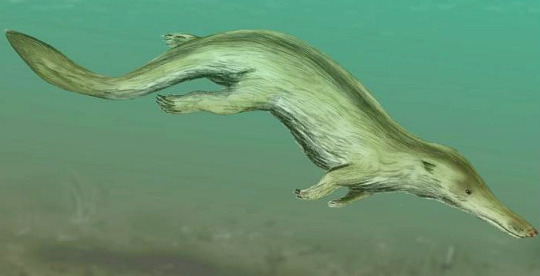
(image: peleoart of Kutchicetus by Nobu Tamura)
The fringe around its neck is the aquatic form of Eevee’s neck ruff, but also makes it look like a sea-lion. No, not the real animals, but a lion mermaid used as a heraldic symbol.

(Image: a sea-lion)
It may also be one big catfish pun. Vaporeon’s ability to turn into water could reference mythical water spirits like naiads.
Omanyte and Omastar are based on ammonites, prehistoric shelled cephalopods that look very similar to, but are not closely related to, the modern nautilus.

(Image: paleoart of an ammonite. source)
Like the nautilus, ammonites could float in the water column using gas-filled chambers in the shell, contrasting the Omanyte line, who are usually depicted as bottom-dwellers. Ammonites would have had the shell opening pointed horizontally, with the tentacles used for grabbing food and a siphon used for propulsion. The Omanyte line instead has the shell opening down and the tentacles used to crawl around. Like any proper cephalopod, Omastar has a powerful beak that it uses to eat. Ammonites first evolved in the Devonian period and made it all the way to the end of the Cretaceous, where they met their end along with the non-avian dinosaurs.
Kabuto is a mix of the horseshoe crab and trilobites. Horseshoe crabs (which you can read about here) are still around now, but they are considered living fossils (a misleading term as the species alive today are not the same as fossil species). Kabuto looks like the carapace of a horseshoe crab, minus the second body segment and tail.
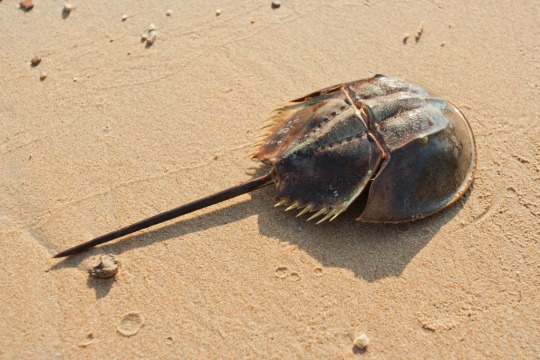
(image: a horseshoe crab)
Horseshoe crabs also have two large eyes on the top of the shell looking up, just like the two dots on Kabuto, and more eyes on the underside looking down. Trilobites had segmented bodies while Kabuto doesn’t. Upon evolving, it takes on some major praying mantis inspiration, but at the same time, it looks a bit more like a triobite. Its head looks like a cephalon of a trilobite, possibly one of the genus Cheirurus, which had some large spikes on the cephalon.
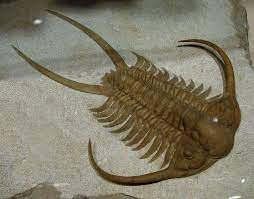
(image a trilobite fossil)
The body is segmented like a trilobites. Kabutops also takes inspiration from eurypterids, relatives of horseshoe crabs that had segmented bodies and large limbs used for hunting or swimming.
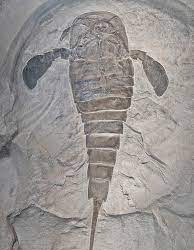
(image: a eurypterid fossil)
Kabutops’s head also looks a bit like a samurai helmet (and the Japanese word for helmet is “kabuto”), and that combined with its sword-like limbs may give it some samurai influence.
Finishing out gen I is the Dratini line, which serve as counterparts to Gyarados. They are also based on a combination of sea serpents and eastern dragons, but while Gyarados is destructive and violent, the Dratini line are reclusive and gentle. Like many eastern dragon myths Dreatini and Dragonair live underwater and/or behind waterfalls and Dragonair has weather control abilities. Dragonite switches to a western dragon, with 4 limbs and wings, but still retains some eastern dragon traits with its serpentine body, ability to live underwater, antennae that look a lot like barbels, and generally gentle behavior. Interestingly, Gyarados has the eastern dragon look but western dragon behavior while Dragonite has the western dragon look and eastern dragon behavior.
Next time, I'll cover the aquatic Pokémon from generation II. In the future I probably wont have to split generations up like this as the other gens don't have as many aquatic mons to cover
22 notes
·
View notes
Text
Ya-te-veo
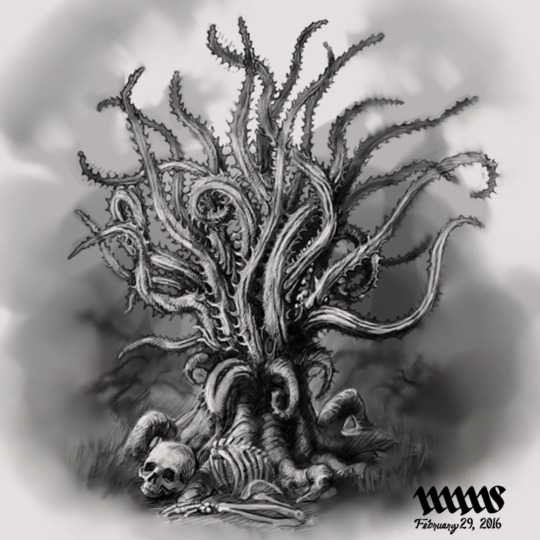
“February 29th, Ya-Te-Veo, the Man Eating Tree” © deviantArt user Sorrow-SixThirty. Accessed at their gallery here
[The ya-te-veo is a literary hoax, appearing in the histrionic (and gloriously illustrated) Sea And Land by James W. Buel, an eight hundred page book about all of the ways that the natural world can kill you. Considering that the book has stories about prehistoric man fighting plesiosaurs, and orangutans as savage killers, it’s clear that this book is the 1880s equivalent of Men’s Adventure Magazines and should be considered just as reliable a source about biology as “Cannibal Crabs Crawl to Kill” or “Weasels Ripped My Flesh!”. And yet, some people consider its claims of “the ya-te-veo, or Man-Eating Tree” of “South America and Central Africa” to be legit. These people are stupid.]
Ya-te-veo CR 6 N Plant This shrub leaps to life, its long leaves edged with saw-like blades. It has a short trunk supported by multiple sturdy roots, on which it pulls itself along slowly.
The ya-te-veo is sometimes called the “sawtoothed shrub” or “man-eating tree”, and these are both accurate appellations. A ya-te-veo is a carnivorous plant with a taste for blood, and it gets it from large prey, including humanoids. Its razor-sharp leaves resemble those of an agave, albeit somewhat thinner and more supple, when the plant is at rest. When active, they spring into action like bladed tentacles, ripping jagged wounds in the plant’s victims. A ya-te-veo can only coordinate two of its leaves at a time to attack prey directly, but the wiggling and writhing of its several dozen appendages still can damage nearby creatures.
Ya-te-veos can move on their roots, albeit slowly, and usually travel by night to avoid detection by potential diurnal prey. They are long lived and slow growing, acting as a more mundane carnivorous plant for the first decade or two of their lives before able to uproot themselves. Ya-te-veos are flowering plants—their flowers are white and ill-smelling, and open at night to facilitate pollination by bats. A ya-te-veo can move through magically altered vegetation with ease, and some druids treat them as pets, making sure that they are well fed and using them as lethal hazards in conjunction with spells like entangle, plant growth or wall of thorns.
Ya-te-veo CR 6 XP 2,400 N Large plant Init +7; Senses low-light vision, Perception +8, scent Aura lashing slashes (10 ft., Ref DC 17) Defense AC 19, touch 12, flat-footed 16 (-1 size, +3 Dex, +7 natural) hp 76 (9d8+36) Fort +9, Ref +6, Will +5 DR 5/slashing; Immune plant traits Offense Speed 10 ft. Melee 2 slams +11 (1d6+4 plus bleed and grab) Space 10 ft.; Reach 10 ft. Special Attacks bleed (1d6), constrict (2d6+6), sawtooth slam Statistics Str 19, Dex 16, Con 17, Int 2, Wis 14, Cha 9 Base Atk +6; CMB +11 (+15 grapple); CMD 27 (31 vs. trip) Feats Combat Reflexes, Defensive Combat Training, Improved Initiative, Skill Focus (Survival), Weapon Focus (slam) Skills Perception +8, Stealth +5, Survival +8 (+12 tracking by scent); Racial Modifiers +4 Survival when tracking by scent SQ camouflage, improved woodland stride Ecology Environment warm forests and hills Organization solitary, pair or grove (3-6) Treasure incidental Special Abilities Aura of Lashing Slashes (Ex) All creatures within 10 feet of an active ya-te-veo must succeed a DC 17 Reflex save each round or take 1d6+2 points of slashing damage. A ya-te-veo can suppress or resume this aura as a swift action. The save DC is Dexterity based. Camouflage (Ex) Because it resembles a mundane plant when at rest, a creature must succeed a DC 20 Knowledge (nature), Perception or Survival check in order to determine that the ya-te-veo is animate. Improved Woodland Stride (Su) A ya-te-veo ignores all difficult terrain or movement penalties created by magical or mundane plant life. Sawtooth Slam (Ex) A ya-te-veo’s slam attacks deal bludgeoning and slashing damage.
39 notes
·
View notes
Text
I think many alleged lake cryptids are just a big-ass long-neck turtle species unknown to science. I mean a massive version of this fella would explain the classic plesiosaur/serpent traits. Plus turtles camouflage so well in murky water that they're natural hide-and-seek champions and are capable of dwelling in deep depths for long periods of time.
Eh. It's just a thought.
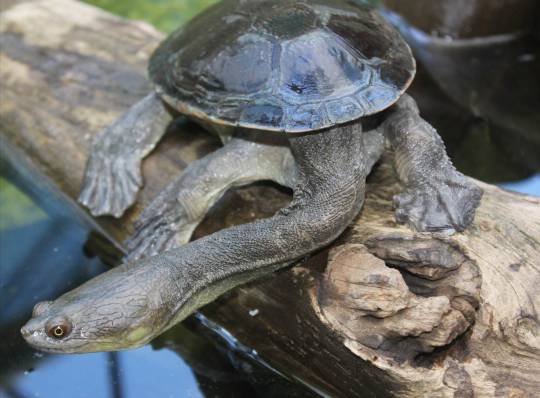
#lake monster#cryptid#lake cryptids#nessie#ogopogo#lake creature#cryptozoology#theory#doesn't explain all or everything#but i find this more plausible than other theories#especially lost dinosaur hypotheses#also turtles are fast in the water#and jumpy and shy AF#they sense you coming they gtfo of dodge#can see a large lake monster turtle bolting that fast too#hence why they aren't seen much
5 notes
·
View notes
Note
I know this is outside of your area of expertise, but do you have any idea why marine tetrapods seem to have a tendency towards evolving extremely large sizes? There are so many more fish than marine tetrapods, but not that many fish have become whale-sized. Cetaceans and ichthyosaurs are the largest animals ever, and mosasaurs, plesiosaurs, and other marine reptiles reached massive sizes too. Why are giant sizes so common among marine tetrapods and why don't we have any blue whale-sized fish?
There have certainly been some suggestions for what might constrain the body sizes of fishes, though very few have been tested extensively, to my knowledge. Out of the factors that have been proposed, the one that is most relevant to the size disparity between marine tetrapods and fishes specifically might be the idea that fishes experience less selective pressure to evolve gigantic body sizes in the first place. Increased body size has an obvious direct benefit to aquatic air breathers in allowing them to store more oxygen and thus stay submerged for longer periods of time, which is of course not a concern to most fishes. It has also been hypothesized that gills are limited in their ability to meet oxygen demands at larger body sizes, though this idea is, from what I gather, very controversial.
In ray-finned fishes specifically, potential constraints on their maximum size include their small larvae (requiring more growth and undergoing metamorphosis to reach larger sizes), the energy required to grow their bony skeletons (which is less of an issue for endotherms), and perhaps competitive exclusion by other clades from lifestyles (such as filter feeding) that would allow them to sustain giant body sizes.
As it happens, sharks notably don’t experience some of these constraints (they do not undergo a larval stage and they have a cartilaginous rather than bony skeleton), which might explain why they appear to have evolved giant body sizes more frequently than ray-finned fishes have. Otodus megalodon, the largest known shark that hunted large prey, appears to have had a combination of additional traits that may have helped attain gigantism: being endothermic and gaining a nutritional boost by cannibalizing unborn siblings during embryonic development.
7 notes
·
View notes
Text
second high thought of the night: sometimes i am baffled by how little people know like i was watching prehistoric planet with my sister and there was a plesiosaur on screen and she was like “dude that totally evolved into dolphins and porpoises” and all i could say was “i don’t know maybe…” and in my head i was like that is such an incorrect guess, clearly dolphins are mammals so it’s much more logical to say that marine mammals were land mammals that returned to the ocean. and resemblances between the form of plesiosaurs and dolphins would be a result of the environment-driven parallel evolution rather than true descended traits
3 notes
·
View notes